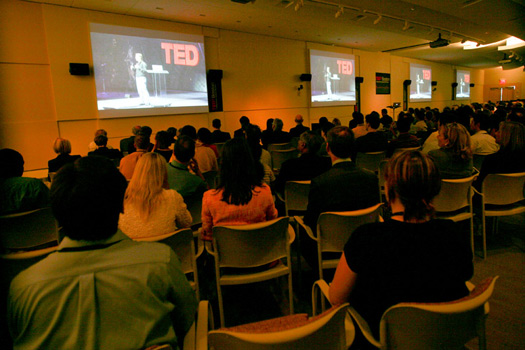
TED blogger Matthew Trost stopped by TEDxBoston on Tuesday. Here, he shares his notes on the proceedings.
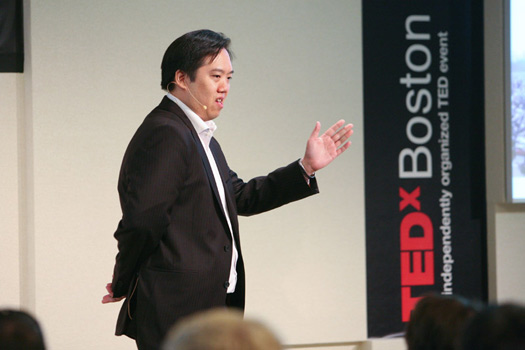 Today’s automobile weighs 20 times its driver, MIT’s Ryan Chin said. It takes up valuable urban real estate. It’s designed to go 100 MPH, while its driver often needs only a quarter of that speed. The supply chain for its petroleum-based fuels is problematic. In New York City, 40% of total gasoline used by cars is wasted on drivers looking for parking spots.
Today’s automobile weighs 20 times its driver, MIT’s Ryan Chin said. It takes up valuable urban real estate. It’s designed to go 100 MPH, while its driver often needs only a quarter of that speed. The supply chain for its petroleum-based fuels is problematic. In New York City, 40% of total gasoline used by cars is wasted on drivers looking for parking spots.
Chin outlined two possible remedies: highly individual transit and mass transit. He looks at Taipei as an example of the former: Scooters are extremely popular there. But a huge “sea” of scooters is cumbersome.
Mass transportation, on the other hand, does not cover an entire city; it’s inconvenient and inflexible. The “first mile, last mile” problem: How does one get to and from public transit?
Chin is designing a “Mobility-on-Demand” system of transportation, where users can rent electric cars, scooters or bicycles at hubs located all around a city.
Chin and his team are also designing vehicles. In his electric car, each wheel is a module that has independent steering, power and locomotion. Without a central engine or drive line, the whole car design scheme changes: you can now fold the car. Each wheel can turn 180 degrees, so the car can turn on its own axis, and move sideways.
These vehicles will be able to plug into renewable energy sources — and sell unused energy back to the grid. Each vehicle will have GPS, so we always know where available vehicles are, where they’re going. Chin proposed a variable pricing structure for his vehicle-sharing system — based on the number of people waiting for vehicles, the number of parking spaces nearby, and proximity to any local rental hub.
David Edwards asked, How do we develop ideas? His answer: We “translate” them to work in different cultural corners.
Humans dream, and develop hypotheses about those dreams. Even simple schemes to realize dreams encounter crises. Crisis results in confusion. We feel frustration, humiliation. But some people love those moments of disorientation, because disorientation is key to learning.
The thrill of figuring things out is fundamental to being alive. In this light, art and science fuse.
We need specialization in order to transmit what we’ve learned to the next generation. Specialization is supported by institutions. But specialization often forces creative people outside of institutions — because they have so many wide-ranging, non-specialized ideas they want to pursue.
He wants to create a network of labs to foster this creative process, so that the cross-disciplinary ideas don’t go to waste. He calls the idea “Culture Labs,” where blue-sky ideas are pulled into realization by the “gravity” of human passion.
Edwards has launched two “idea translation labs,” one in Paris and one at Harvard. In these labs, students do art and science experiments. One experiment gave people the experience of a stem cell becoming a neuron. Another experiment created a soundless composition based on the idea of infinity.
Changing culture, he said, makes you pay attention. He’s hoping to foster a new Renaissance through a $100K Art Science Prize.
Read more notes from TEDxBoston >>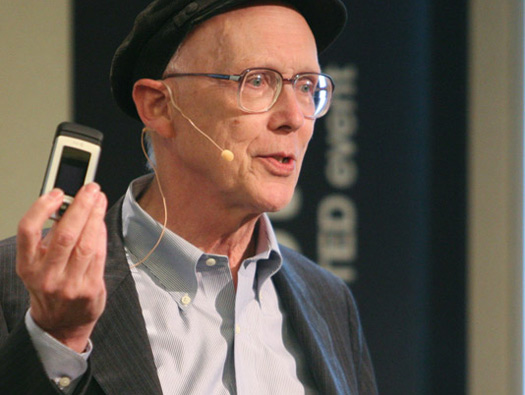 John Hoffman, VP of HBO Documentary Films, wants to leverage HBO’s huge audience reach to make a difference.
John Hoffman, VP of HBO Documentary Films, wants to leverage HBO’s huge audience reach to make a difference.
Hoffman’s father died at age 80 of Alzheimer’s disease. A colleague soon asked if he wanted to do a show about the disease. At first Hoffman refused, perceiving that there was no hope for sufferers of the disease. (Alzheimer’s is the second most-feared illness in the USA.) But if there’s reason for hope, he said, then an entertainment company has an opportunity to play a tremendous role. So he planned a series of documentaries about the disease.
The films had to be about more than just the science — they had to capture the experience of the disease. The Memory Loss Tapes is a film that tells story of seven people, each with a more advanced state of the disease. Caregivers explores how the caregivers of Alzheimer’s sufferers can take care of themselves and others. Momentum in Science looks at the optimism in the medical community about finding a cure.
By collaborating with the NIH, Hoffman’s team was able to watch real scientists begin to unravel the disease and create treatments. They were literally on the front lines of the illness. Through the process of creating the films, he learned about the risk factors — and the preventative measures (such as exercise) that are giving people at risk hope.
Bill Jacobson asked, How can we be inspired by the art around us? The Mona Lisa is behind glass. She smiles because she knows that no matter what viral videos sweep the world, she will always draw the crowds. Yet, on average, people spend three seconds in front of an object at a museum.
Jacobson’s project, MuseTrek, connects people with art and culture using information on site and online. We’ve all been on a city block or museum and been captivated by what we’ve seen. We now live in a world where contextual info is always in our pocket. The key is making that contextual information available.
MuseTrek allows people to create stories, their own “museum tours” of objects around them. This is enables people to define their own neighborhoods and tell their own stories. It’s a valuable guide for tourists and locals alike.
Visitors at the Louvre once bought canvas and paint to try to recreate the masterworks. Digital media can be the new way to do that.
Hugo Van Vuuren‘s story began when he took a class at the Harvard Idea Translation Lab. He learned about low-cost lights, and wondered about using them to light up Africa.
He has traveled all throughout Africa. Once, walking, he noticed wires running through the dirt, connecting informal settlements to a makeshift electric grid. Residents used these wires to power DC devices such as reading lights.
Africa has a major distribution problem that affects electrical connectivity as well as food and other resources. Yet, interestingly, many African cultures use the Ubuntu concept of “I am because you are.” Its basis is in generosity and sharing. This is the native distribution network for Africa. But how do you get it to work with assets like electrical power?
With the Sahara about to become a hub for solar power, the question is, How to we get that power to Africans? It’s a pervasive issue in Sub-Saharan Africa. Also, how to we get the investment we need to create the infrastructure?
Van Vuuren’s team is looking at microbial fuel cells. When microorganisms metabolize waste in the soil, they create electric charge that can be captured. He wants to use this technology to power highly efficient LEDs and simple radios. Simply dig a hole, bury the fuel cell bag, and it generates power to charge a battery.
He wants to create a power platform that supports the devices already in Africa — such as cell phones, which are cheap and already well adopted.
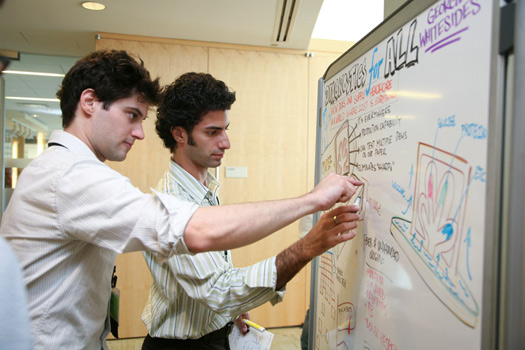 Josh Wachman gave a talk called “On the Future of Medication Packaging and Being a Jerk.” He asked, What world will my daughter grow up in? The world has changed in terms of consumer products, but also in our attitudes. What if we could upgrade our actual behaviors? Wachman thinks we can create products that actually change worldwide behavior.
Josh Wachman gave a talk called “On the Future of Medication Packaging and Being a Jerk.” He asked, What world will my daughter grow up in? The world has changed in terms of consumer products, but also in our attitudes. What if we could upgrade our actual behaviors? Wachman thinks we can create products that actually change worldwide behavior.
To start, he wants to improve adherence to prescription medicine. Millions of people stopped taking Lipitor during the first period. There are many causes of non-retention, such as the hassle of taking medication.
He proposes smart medication packaging — bottles with caps which glow and buzz more and more insistently, making people aware of the necessity of taking their medication. The caps record and upload data that is collected to show overall adherence rates. Patients are contacted if they miss a dose. Data is shared with loved ones. Coupons arrive in the mail. Doctors are kept in the loop.
The system also stops people from needing to worry, “Did I take this already?” Glow caps helped users in a trial achieve 86% adherence — way higher than the 50% benchmark adherence of the pharmaceutical industry.
George M. Whitesides, a Professor at Harvard, has founded 12 companies, co-authored 900 scientific articles, and is listed on 50 patents.
Whitesides said, “I am a wonk.” Wonks are defined by a certain view of the world. Once, he was cleaning an attic, lifting heavy stuff. He woke up later that night in pain. He went to the ER, fearing it was a heart attack. The diagnostics to determine if he needed treatment resulted in a huge expense.
What about in the developing world? How does one supply healthcare in a world where cost is everything? He suggests a world where we know what you’re treating first, and then treat it. He wants to make diagnostics free — diagnostics for all.
He’s inspired by military medicine, which is similar to developing-world medicine: based around low resources, using field medicine and lightweight kits.
What would the equivalent diagnosis for his pain have been if he were in the developing world? There’s a public lab option: limited in resources. And there’s a private entrepreneur option: sketchy.
How do you lower cost of a medical tool for use in the developing world? Typically, we look at our own, expensive method as a starting point, and try to reduce cost from that point. Instead, we ought to say, “What is the cheapest stuff we can use to make a diagnostic system?” Paper is perfect for the task. Whitesides designed a small pad the size of a fingernail. You dip it in urine and it turns colors, which are used to diagnose illness.
How do you make this device? A simple manufacturing processes using printers.
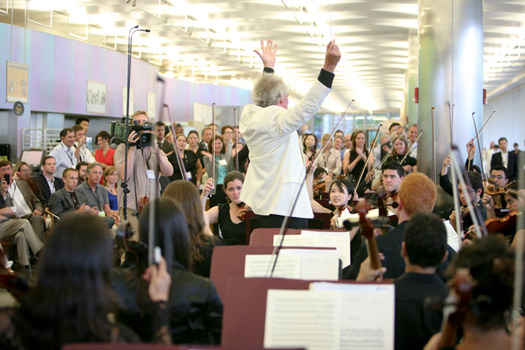 His system also eliminates “sharps” such as needles from diagnostics. “Sharps” are a disposal hazard. With paper, you just burn it to dispose of it. “The healthcare worker of the future is not a PhD. He’s an 18-year-old with a backpack full of these sheets.”
His system also eliminates “sharps” such as needles from diagnostics. “Sharps” are a disposal hazard. With paper, you just burn it to dispose of it. “The healthcare worker of the future is not a PhD. He’s an 18-year-old with a backpack full of these sheets.”
There are still challenges. You must be able to send useful info to a processing center over a poor telephone system. How do you know colors will be accurately transmitted? He uses the Mars Rover as an example: NASA asked, “How do you get accurate color from Mars when bandwidth is limited?”
Whitesides is now looking into advanced devices, with flow systems built of several layers of paper. A single blood or urine sample distributes itself through the channels of wick, snaking through layers of paper. At the last layer, 16 dots to which the liquid has pooled change colors, representing results for 16 different tests.
He’s interested in other such low-cost health care solutions. For example, in the developing world, how do you separate blood cells from serum? A centrifuge. What if you don’t have one? He designed a way to use an egg beater to power a centrifuge. Sadly, his egg beater centrifuge was rejected from publication in a science journal. They told him, “We only publish science.”
Melissa Withers wants to improve elder care. Here, she introduced the “warehousing problem”: where do you put the aging population that cannot care for itself? In the USA, there are more nursing homes than McDonald’s restaurants. How and where will we build the newer ones?
Of the 80 million born just after WWII, 77 million are still alive, and they are going to need intense, extensive care. That’s going to cost hundreds of billions of dollars.
Aging is not linear. It’s very complex and circuitous. Elders may go through five or more stops before they arrive at the pearly gates: Home to hospital to rehab to assisted living to nursing home to your home …
Her project, “Meet Our Friends,” shows the elder care process from the eyes and ears of elders living in a skilled nursing and assisted living center. She showed video of elders talking about their lives, their feelings. “We only have one thing to live for: watching our children grow. I thank God every day for that.”
She also followed elders through intimate routines like showering, toileting, and uncovered how fundamental their problems really are. Eating, dressing, moving, paperwork, finances, medication, relationships … these are not simple daily routines to elders, but seriously difficult challenges.
Technology is an unexploited opportunity in this space. How might it help with mobility? With entertainment? With interpersonal connections?
What if elders themselves could engage in R&D toward servicing their own needs? Withers is working on doing just that.
Photos (top to bottom): the TEDx audience; Ryan Chin; George Whitesides; whiteboarding between sessions; Benjamin Zander conducting the Youth Orchestra of the Americas. Credit: FayFoto Studios/Boston.
Comments (2)